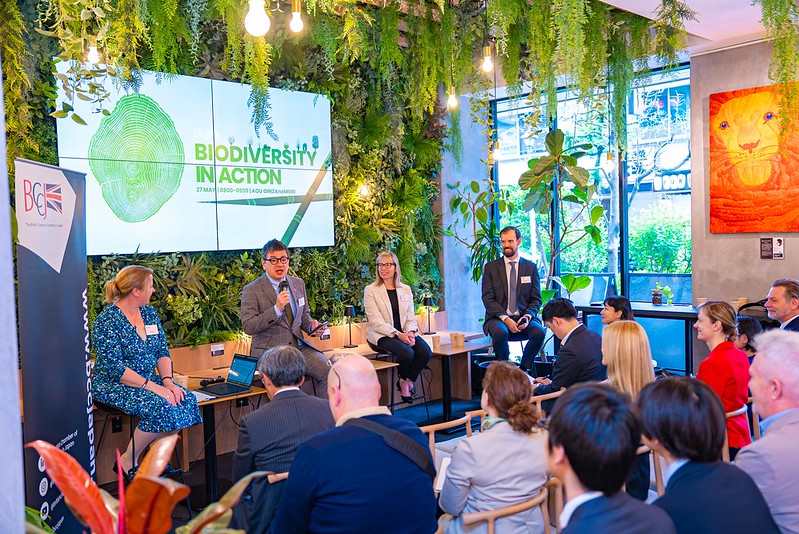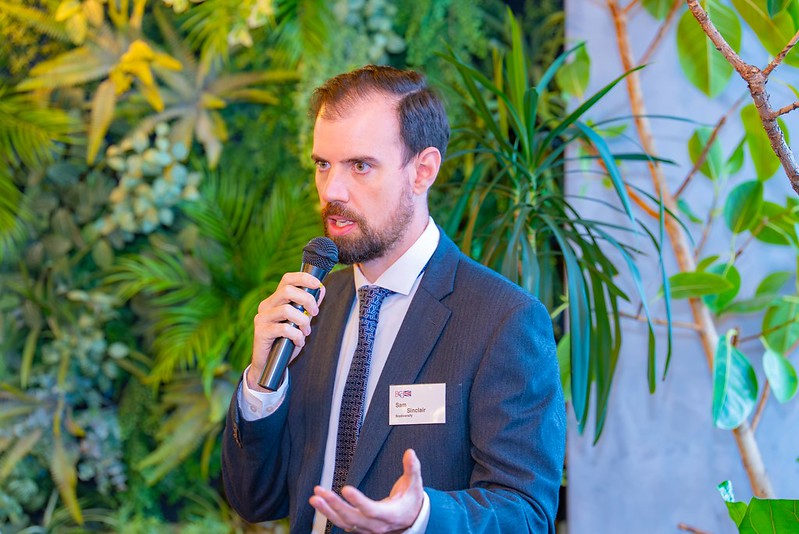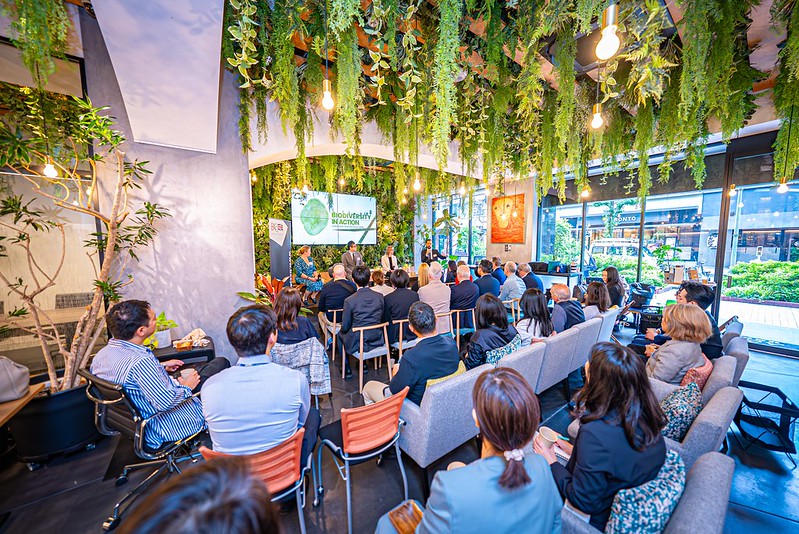Biodiversity in Action: Turning Corporate Strategy into Tangible Impact
Biodiversity in Action: Turning Corporate Strategy into Tangible Impact
Biodiversity is not only an environmental issue but an economic and social one, too. The World Health Organization estimates that the global economic impact of biodiversity loss amounts to US$ 10 trillion annually, including healthcare costs from increased disease transmission and agricultural losses resulting from a decline in pollinators. So, how can businesses in Japan and the UK respond to this global challenge?
On May 27th, the British Chamber of Commerce in Japan invited experts to share what their organisations are doing to build biodiversity strategies and to explain the tangible business impact of their actions.
The panel comprised Maggie O’Neal, Global Head of Sustainable Investing Research at Barclays; Harumichi Seta, Biodiversity/Nature Lead & Senior General Manager of Sustainability Management at Suntory Holdings; and Dr Sam Sinclair, Co-Founder & Director of Biodiversify, with discussion facilitated by Tove Kinooka, Director & Co-Founder, Global Perspectives K.K.

Climate change-induced supply chain risks
Sinclair said businesses often first approach biodiversity with frameworks such as SBTN (science-based targets network) and TNFD (Taskforce on Nature-related Financial Disclosures) to assess their supply chains and their impacts on biodiversity, including where goods are sourced and their impacts.
“It’s only recently that people have started to understand their supply chains well enough to really locate where things are grown or harvested. When you dig into that, you realise the risks they’re exposed to are quite major in terms of the threat to the company,” he said.
He cited examples such as the fourfold increase in cacao prices in 2024 due to deforestation in Africa – a “massive price shock risk.”
“The deforestation caused increased climate-change impacts, decreased rainfall and a host of other impacts, which massively increased the price—something that, for many organisations, would be fatal if the core commodity that your company depends upon went up four times in a year. There are very few organisations that can survive that,” he said.
“Nature doesn’t really show up on your systems; you don’t witness the impacts until suddenly there are two or three droughts in a row, or another major event, and then there’s a sudden crash—of productivity or yield. Prices soar, or the resilience of your supply chain drops, and suddenly you’re exposed to an organisation-threatening event.”
Biodiversify is working with global businesses such as Amazon, Primark and Tetra Pak to assess their supply chain resilience, with a focus on helping business leaders make “robust, accountable decisions,” he added.

Barclays’ O’Neal said while climate impacts could be assessed relatively easily, “there isn’t a one-sized-fits-all solution” for biodiversity metrics.
“TNFD is a great starting point, and we’re seeing more and more companies embrace that. As companies start to report under that—even though it’s more qualitative than quantitative—it’ll start the discussion, which will help investors have more data on what they need to look at,” she said.
“Right now, we’re finding investors are often using proxies, because that is where you have the data available at this point in time—depending on the company’s exposure: water use, deforestation, pollution, plastic waste.
“In almost every meeting, biodiversity or nature comes up as a topic that investors want to discuss and want to find more ways to invest in,” she added.

Suntory’s Seta cited the importance of the ecosystem for production of the company’s famous whisky brands such as Hibiki and Yamazaki.
“The greatest pressure driving our biodiversity initiatives is the inherent need to secure a stable supply of water and agricultural growing regions, which are the foundation of our business growth,” he said.
“Climate change is causing major changes to ecosystems: climate change and biodiversity loss have impacted the supply of water and crops, both posing a direct risk to our business. In fact, over the past five years, we have seen a significant increase in the frequency of emergency changes to our procurement sources.”
He said Suntory aims to conserve water resources and promote regenerative agriculture, including through the Natural Water Sanctuary and Kumamoto Water Positive Action initiatives in Japan and activities to preserve peatlands in Scotland.
“We recognise that relying on traditional procurement methods and agriculture will make it increasingly difficult to procure raw ingredients such as water and crops sustainably,” he said.

Green policy, human impact
During the Q&A session, panellists were asked about legislation regarding biodiversity, the impacts of “green” technologies and the opportunities from future-proofing supply chains, such as helping empower women by encouraging sustainable harvesting.
Sinclair pointed to the benefits for employees as well as business relationships: “Nature has a very strong emotional connection, which means that if you’re acting to restore an area, that can provide benefits to staff—you see increased staff retention rates, staff happiness, staff wellbeing,” he said.
“Also, with your suppliers, they can see that you are taking them seriously, and you are taking the viability of their businesses seriously, which then means when you do get shocks and crises, you have very loyal suppliers … that’s another layer of resilience,” he added.
Government initiatives
At the event’s close, attendees heard from Takafumi Osawa, Head of the Biodiversity Mainstreaming Department at Japan’s Ministry of Environment, who explained why the government has launched national “Biodiversity Action Plans” including area-based conservation.
“According to the Kunming–Montreal Global Biodiversity Framework, each country is supposed to achieve ‘30 by 30,’ which means we must protect or conserve at least 30% of land and oceans by 2030,” he said.
“In Japan, protected areas already cover more than 20% of land and more than 13% of oceans, but there is still a big gap between our current numbers and 30%. We will try to expand protected areas, but we would also like to involve the private sector, because some companies in Japan have small green areas—forests around factories, for example, and those surrounding shrines.”
The ministry also recently launched a “nature-positive economy” strategy, working with the TNFD and encouraging companies and local economies to better manage natural resources, he said.


